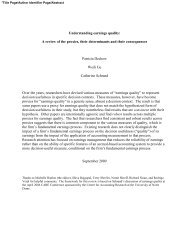Sony's Battle for Video Game Supremacy - MIT Sloan School of ...
Sony's Battle for Video Game Supremacy - MIT Sloan School of ...
Sony's Battle for Video Game Supremacy - MIT Sloan School of ...
Create successful ePaper yourself
Turn your PDF publications into a flip-book with our unique Google optimized e-Paper software.
SONY'S BATTLE FOR VIDEO GAME SUPREMACY<br />
John Sterman, Kahn Jekarl, Cate Reavis<br />
Nintendo’s next system, the Super Nintendo launched in September 1991, did not capture the market<br />
like its predecessor. Super Nintendo’s lack <strong>of</strong> backwards-compatibility prevented Nintendo from<br />
taking full advantage <strong>of</strong> its existing catalog <strong>of</strong> games. Meanwhile, Sega, another Japanese home<br />
console manufacturer, had successfully entered the U.S. market two years earlier with the Sega<br />
Genesis console and effectively fought Nintendo to a draw. Strong internal game development at<br />
Sega coupled with relatively favorable terms <strong>for</strong> s<strong>of</strong>tware licensees (in comparison to Nintendo)<br />
paved the way <strong>for</strong> an extremely competitive library <strong>of</strong> titles <strong>for</strong> the Sega Genesis.<br />
By the mid-1990s, Sega was the least <strong>of</strong> Nintendo’s worries as Sony entered the video game market<br />
with a bang.<br />
8BSony Enters the Arena<br />
Believing that a three-dimensional (3D) game could provide a more immersive experience than a<br />
traditional two-dimensional (2D) game, the Sony PlayStation, launched in 1994, was designed as a<br />
fully three-dimensional machine. Ken Kutaragi, the lead architect <strong>for</strong> the PlayStation, believed game<br />
players were eager to navigate 3D environments that were more life-like than 2D, side-scrolling<br />
games such as Super Mario Brothers. Ready <strong>for</strong> the jump in complexity, gamers rushed to purchase<br />
the PlayStation. Within two years <strong>of</strong> launch, PlayStation revenues reached $700 million with pr<strong>of</strong>its<br />
8<br />
<strong>of</strong> $70 million.F<br />
Sony opted <strong>for</strong> the compact-disc <strong>for</strong>mat instead <strong>of</strong> the traditional cartridge <strong>for</strong>mat that Nintendo<br />
historically utilized. CDs held up to 20 times more in<strong>for</strong>mation than a standard cartridge and allowed<br />
game developers to create the more intricate characters and environments required <strong>for</strong> a 3D<br />
experience. The potential downside <strong>of</strong> the CD <strong>for</strong>mat was the “seek time” needed <strong>for</strong> in<strong>for</strong>mation to<br />
9<br />
be read from the disc, making CDs 50 times slower than a cartridge.F F Advanced<br />
data <strong>for</strong>matting,<br />
however, minimized disruptions to the game-play experience. CDs were also attractive to Sony and<br />
its licensed developers because their production costs were falling below costs <strong>for</strong> cartridges. By the<br />
late 1990s, the manufacturing cost <strong>for</strong> a CD game was about $1.50 per unit compared to $12.00 <strong>for</strong> a<br />
10<br />
cartridge game.F<br />
When it came to the library <strong>of</strong> games that were available <strong>for</strong> the PlayStation, Sony took a much<br />
different approach than Nintendo and was less restrictive about the number <strong>of</strong> games that were<br />
released <strong>for</strong> the PlayStation. Sony recognized that competing with Nintendo on a game-to-game<br />
basis would be difficult. Nintendo had the very best game developers in the world. Sony believed<br />
that a greater selection <strong>of</strong> titles <strong>for</strong> the consumer would be the best chance to topple Nintendo. While<br />
still maintaining a detailed approval process <strong>for</strong> game developers, Sony succeeded in creating a robust<br />
8 Robert Le Franco, “Take That, Nintendo,” Forbes, June 3, 1996, p. 96.<br />
9 Peter J. Coughlan, “Note on Home <strong>Video</strong> <strong>Game</strong> Technology and Industry Structure,” HBS Case No. 700-107, June 13, 2001.<br />
10 Ibid.<br />
Rev: December 8, 2011 6
















